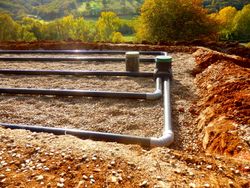What's the Difference Between Standard & Aerobic Septic Systems?

According to the Department of Environmental Protection, roughly 26% of Pennsylvania households have septic systems on their properties. These systems made up of septic tanks, drain fields, and other components that treat the household sewage and wastewater leaving your home. They’re designed to prevent the spread of disease and keep harmful bacteria from contaminating the environment, especially water supply sources. Below is a quick guide on the two types of septic systems—standard and aerobic—and how to know which one is best for your property.
A Guide to Standard & Aerobic Septic Systems
Standard Systems
Also called conventional or anaerobic systems, standard types use bacteria that do not need oxygen to survive. From your home, sewage flows into an underground septic tank. The solid wastes (sludge) sink to the bottom while lighter substances like grease and oil float on top (scum). These layers stay in the tank while the liquid in between (effluent) moves to the distribution box if you have a gravity system, or the dosing tank if you use a pressure system.
 These mechanisms pump the effluent to the absorption area, where it exits through pipes into a layer of gravel. The fluids then percolate through the soil, where bacteria further treats the wastewater.
These mechanisms pump the effluent to the absorption area, where it exits through pipes into a layer of gravel. The fluids then percolate through the soil, where bacteria further treats the wastewater.
Aerobic Systems
Aerobic systems use bacteria that need oxygen and treat your sewage using three tanks. From households, waste moves to the trash tank where solids settle to the bottom. The sewage then moves to a second tank (aerobic treatment unit) where an aerator releases oxygen bubbles, enabling aerobic bacteria to break down the wastes. The liquid then moves to the third section (pump tank) for additional treatment, before being filtered into the soil or reused for irrigation.
Which One Is Right for My Property?
Aside from the type of bacteria used, these systems also differ in terms of cost, maintenance, percolation level needed, and other site requirements.
-
Cost: Standard systems are cheaper and easier to install. Aerobic systems require electrical components and extra tanks and thus cost more to build.
-
Maintenance: Aside from septic tank pumping every 3-5 years, standards systems need very little maintenance. In contrast, aerobic systems require regular aeration and care.
-
Percolation Rate: Standard systems are used in areas where liquids can easily move through the soil. If the land in your area cannot absorb water quickly, you need to use an aerobic system.
-
Site Requirements: Standard systems work best in areas with large drain fields and gentle slopes. Meanwhile, aerobic systems are used by property owners with limited leach fields, flat land, or high water tables.
If you need septic tank installation or maintenance services in Union County, PA, contact Mark Cromley Septic & Excavation Service. Their team has been servicing residential, commercial, and industrial clients, providing septic tank pumping and repairs as well as excavating work. If you have questions, give them a call at (570) 524-0249 or visit their website.
About the Business
Have a question? Ask the experts!
Send your question

